Lamborghini
|
1963 - present |
Country: |
 |
|
Was Ferruccio Lamborghini Snubbed Or Dissatisfied?
The story of Lamborghini begins naturally
enough with Ferruccio Lamborghini, who was born on April
28, 1916 in a small Italian farming village by the name
“Renazzo di Cento” in Ferrara.
Ferruccio’s
parents noted early on that their son had a keen aptitude
for anything mechanical, and so in WWII he was drafted
into the Italian services where he repaired military
vehicles.
After the war he turned his talents toward
the manufacture of tractors from spare parts –
no doubt in an effort to help his country recoup after
suffering the devastation of the war years. His manufacturing
empire quickly grew in stature, and not only included
the production of tractors but also industrial heating
equipment.
But as is the case with most men, his heart was captured
by the
automobile and, ever since winning the
Mille Miglia in 1948, he had aspired to become a manufacturer
in his own right.
His wealth afforded him the luxury
of purchasing a new Ferrari; speculation however remains
as to his being snubbed by Enzo Ferrari himself or,
more likely, he being dissatisfied with his own Ferrari
and confident that he could build something much better.
The Founding Of Lamborghini Automobili
In 1963 Ferruccio founded the “Lamborghini Automobili”
company, and choose the symbol for his astrological
birth sign, the Bull, as his new marques emblem. The
Lamborghini factory was established at Saint Agata Bolognese,
some 20 miles (32 km) from the Ferrari plant at Maranello.
Ferruccio hired the extremely talented Giotto Bizzarrini
to design the engine, and equally talented Gianpaolo
Dallara to design the chassis. Wisely, Ferruccio had
chosen men with previous experience at the design facility
at Ferrari, the company he firmly had in his sights
as his main rival.
In March of 1964 the first production car arrived,
the 350 GT. It was this car, together with the 400 GT
and the 400 GT 2+2 that made the Lamborghini name known
throughout the world; and it was the “
Miura”
that made it legendary – but we are getting ahead
of ourselves! The 350 and 400 GT’s were relatively
conventional front-engined cars, but making the conventional
extraordinary was the magnificent quad-cam V12 engine
of 3.5 and 4 litres respectively. But to compete with
his arch rival, Ferruccio needed a mid-engined car; the
answer came in the form of the mighty Miura.
The Miura Becomes The Benchmark Super Car
Originally the Miura was designed as a racing sports-car,
but Ferruccio could see the blistering performance of
the car would prove a Ferrari killer and so ordered
his design team to tame the beast into something capable
of road use. Rather than mount the engine in a traditional
North-South configuration, the designers choose to mount
it transversely across the frame and mate it to a silky-smooth
5 speed all-synchro gearbox.
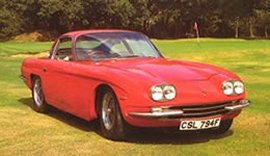
Dissatisfaction with his Ferrari
would lead Ferruccio Lamborghini to develop the
beautiful 350GT...
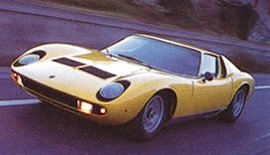
Even after retirement the Miura
would be close to Ferruccio's heart; he would
go on to produce a red wine called "Colli
del Trasimento" or "Blood of the Miura"...
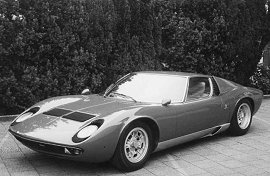
The "Miura" is a fearsome breed of
Spanish fighting bull, the Pajero is Spanish
for...
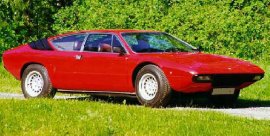
The Urraco was the first ever
2+2 seater car with a mid-mounted engine configuration...
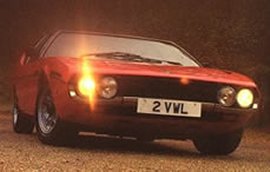
The Espada offered much better
performance over the Urraco, courtesy of its
sweet mid-mounted V12 engine, but amazingly
still offered 2+2 seating...
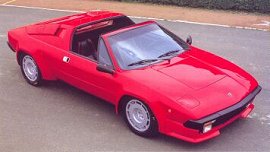
The Jalpa was the last to be
based on the design of the original Urraco;
it gained a 'Targa' roof but lost the two rear
seats...
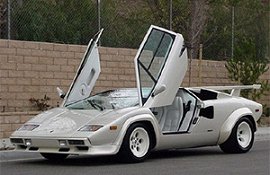
Look what happens when you tell the designers
that money is no object; you get funny doors...
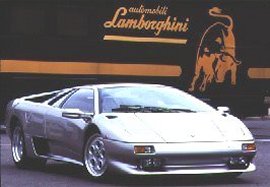
The Diablo, its performance in tune with its
price-tag, breathtaking! |
The exterior was styled
by Bertone and, in keeping with the ‘Bull’
theme, the car was dubbed the Miura – a fearsome
breed of Spanish fighting Bulls. Despite the cars pedigree, Lamborghini management knew
the cost of the car would preclude most purchasers and
so intended for a very short production run.
When it
was launched at the Geneva Motor Show of 1966, the resultant
flood of orders would force a quick change of plans
– little did Ferruccio know his beloved Miura was
about to become the Super-car of the 1960’s!
The lovely shape of the Miura was made distinctive
by the use of retractable headlights, laying flush with
the bonnet and facing skywards when not in use. To top
it off, "eyelashes" were added to the flip-up
lights to create an extremely good looking front, while
the louvered engine cover at the rear made it arguably
the best-looking Lamborghini ever.
The first engine
fitted to the Miura was good for 350bhp at 7000rpm,
but the subsequent Miura 400S produced an amazing 370bhp,
a figure that would continue to grow with the later
SV version.
The P400 and P400S models were considered
by many to be the more refined cars, both good for
a top speed of around 170mph (273.5 km/h) although
they naturally used copious amounts of fuel. The Miura
production would last for eight years, through to
1973, by which time some 762 had been manufactured.
The More Practical Urraco
Less revered, but far less expensive, the V8 engined
Urraco afforded the family man an excuse to buy a Lamborghini
by provision of 2+2 seating. However the timing of its
release could not have been worse, coinciding with the
1970’s fuel-crisis.
Those that could afford a
Lamborghini, an expensive one that is, could easily
cope with the added cost of fuel, but the less well-heeled
remained fearful of the prospect of owning a V8 (or
V-anything for that matter) and the expected sales did
not eventuate.
Technically speaking, the Urraco was quite interesting.
Apart from Lamborghini fans, most that have read this
will be expecting the Urraco’s layout to be front-engined
– and yes they would be wrong. It was the very
first 2+2 mid-engined car in the world, coming even
earlier than the Ferrari 308GT4.
Now used to the enormous
power of the infamous Lamborghini V12 engines, the Urraco’s
single-overhead-cam 2.5 litre V8 seemed thoroughly underwhelming
– a fact that car reviewers the world over were
quick to point out! Lamborghini upgraded the engine
to a 3 litre DOHC unit (dubbed the Urraco P300), this
latter car proving to be an excellent GT, with sensuous
handling accompanied with excellent brakes.
Between 1974 and 1976, only 776 Urracos were made (see
the gallery page for a breakdown of manufactured numbers
by model), which was well below Lamborghini's expectation.
Lamborghini would try to breathe new life into the car
with a makeover named the Silhouette, much like the
original Urraco but fitted with a “Targa”
roof. Finally the car would transform into the 2 seater
“Jalpa”, before finally ending production
in 1988.
But back to the V12’s – and Super-car performance.
Lamborghini again designed a racing sports-car, the
formidable “Countach”, its name coming from
the Piedmontese exclamation of amazement!!
The Countach Is Revealed In Geneva
The Countach
was first seen at the 1971 Geneva motor show, born from
the design brief that it should be “to build the
ultimate no-compromise high-performance road car”.
As cost was not mentioned in the brief, the designers
discarded its consideration and delivered arguably the
most evocative and desirable sports car design to date.
Styled by Bertone, the doors were a stand-out feature,
swinging forward and then upward from low-mounted front
hinges.
The chassis was a very complicated multi-tubular structure,
in which the famous V12 unit was mounted lengthwise
behind the cockpit. However, the five-speed transmission
was ahead of the engine, protruding into the cockpit,
and drive to the rear wheels was by a propeller shaft,
through a tube in the engine sump, to the final drive.
As a consequence, the driving position
was a long way forward, but the car's centre of gravity
was low, and there was a 43/57 percent front/rear
weight distribution. There was even space for some
luggage behind the engine itself, but we think this
was more the result of good fortune rather than the
designers actually considering such a requirement.
Power was originally 375bhp from the 3929cc engine,
but emission legislation required the engine to be
enlarged to 4754cc, offering no additional power but,
on the up-side, slightly improved torque. A rear spoiler
wing was optional, and top speed was at least 180mph
(289.6 km/h).
It was not long after the release of the Countach that,
in 1973, Ferruccio would sell all of his companies and
go into retirement at his vineyard in Italy's Umbria
province. He would go on to produce a red wine called
Colli del Trasimento know as "Blood of the Miura"
– obviously pointing to the car he most loved.
He died on February 20, 1993 at the age of 77.
Also see: Lamborghini Car Reviews 


